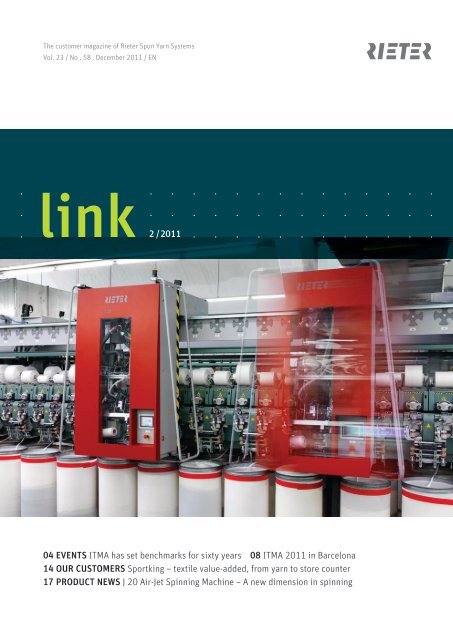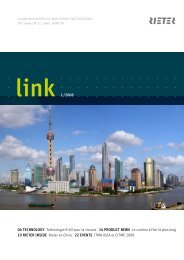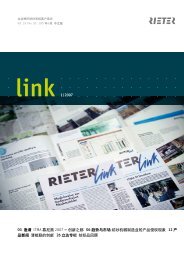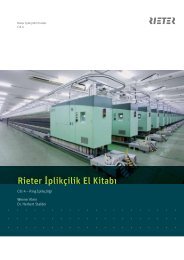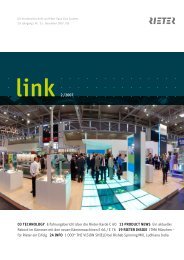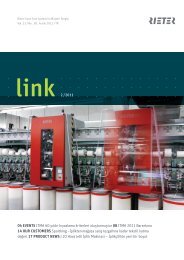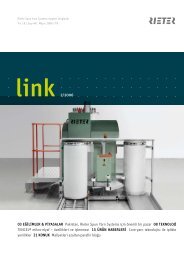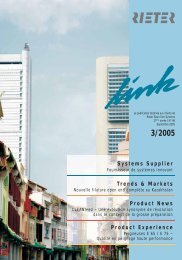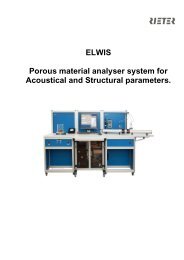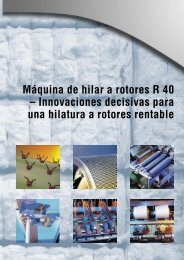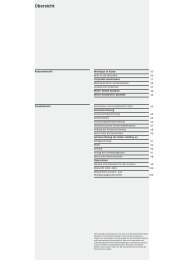Download LINK - Rieter
Download LINK - Rieter
Download LINK - Rieter
You also want an ePaper? Increase the reach of your titles
YUMPU automatically turns print PDFs into web optimized ePapers that Google loves.
The customer magazine of <strong>Rieter</strong> Spun Yarn Systems<br />
Vol. 23 / No . 58 . December 2011 / EN<br />
link 2<br />
/2011<br />
04 EVENTS ITMA has set benchmarks for sixty years 08 ITMA 2011 in Barcelona<br />
14 OUR CUSTOMERS Sportking – textile value-added, from yarn to store counter<br />
17 PRODUCT NEWS J 20 Air-Jet Spinning Machine – A new dimension in spinning
2 <strong>LINK</strong> 58 . 2 /2011<br />
CONTENTS<br />
Cover:<br />
Highly productive and operating with<br />
up to 4 robots - the new J 20 Air-Jet<br />
spinning machine.<br />
Publisher:<br />
<strong>Rieter</strong> Spun Yarn Systems<br />
Editor-in-chief:<br />
Nadia Qaud<br />
Copyright:<br />
© 2011 <strong>Rieter</strong> Machine Works Ltd.,<br />
Klosterstrasse 20, CH-8406 Winterthur,<br />
www.rieter.com, rieter-link@rieter.com<br />
Reprints permitted, subject to prior approval;<br />
specimen copies requested.<br />
© Photos from ITMA Barcelona<br />
Javi Arriaga, Spectrafilms, Bilbao, ES<br />
spectrafilms@gmail.com<br />
Design and production:<br />
Marketing <strong>Rieter</strong> CZ s.r.o., P. Bielik<br />
03 EDITORIAL<br />
EVENTS<br />
04 ITMA has set benchmarks for sixty years<br />
It was held for the first time 60 years ago – and has<br />
established itself as the textile industry's summit<br />
conference. The ITMA has also been very important for<br />
<strong>Rieter</strong> for 60 years. A look at <strong>Rieter</strong>'s pictorial archive.<br />
08 ITMA 2011 in Barcelona<br />
The ITMA in Barcelona opened its doors to an<br />
international trade audience on September 22, 2011.<br />
You will find impressions from the exhibition in<br />
Barcelona in this issue of <strong>LINK</strong>.<br />
OUR CUSTOMERS<br />
14 Sportking – textile value-added, from yarn to store<br />
counter<br />
Sportking is well on the way to becoming one of the<br />
biggest brands at all stages of the textile process, from<br />
yarn and fabric manufacture to apparel production<br />
and retailing; not only on the Indian market, but<br />
worldwide.<br />
PRODUCT NEWS<br />
17 J 20 Air-Jet Spinning Machine – A new dimension in<br />
spinning<br />
The J 20 is a marvel of production in the minimum of<br />
space. With its 120 spinning units and high output<br />
of 450 m/min under mill conditions, the J 20 airjet<br />
spinning machine is at the top of the productivity scale.<br />
23 SPIDERweb – spinning mill data at a glance<br />
25 The right draw frame to meet every need<br />
PARTS<br />
26 <strong>Rieter</strong> nippers<br />
27 Improved package build with anti-patterning<br />
control
Fig. 1 "The Comfort<br />
of Competence"<br />
campaign. At center<br />
stage Christoph Ziltener<br />
of Flawa AG in Flawil,<br />
Switzerland, the winner<br />
of the competition to<br />
find "The oldest <strong>Rieter</strong><br />
spinning machine in the<br />
field".<br />
Dear <strong>LINK</strong> readers:<br />
The first ITMA was held 60 years ago in Lille, Northern<br />
France. <strong>Rieter</strong> has attended the ITMA since 1951<br />
– each time exhibiting pioneering innovations. <strong>Rieter</strong><br />
has been a major influence on the development and<br />
continuous improvement of yarn manufacturing<br />
quality – a glance into the photographic archive illustrates<br />
the story of the innovations that have<br />
emerged from the <strong>Rieter</strong> company. You can see in<br />
this issue of Link how <strong>Rieter</strong> and Schubert & Salzer,<br />
today’s <strong>Rieter</strong> Ingolstadt GmbH, have exhibited their<br />
products over these 60 years.<br />
Live at the ITMA 2011 in Barcelona<br />
The following new products were exhibited here for<br />
the very first time: the C 70 high-performance card,<br />
the R 60 rotor spinning machine, the J 20 airjet spinning<br />
machine and Version 6.0 of the SPIDERweb mill<br />
monitoring system. The flexibility of the K 45 compact<br />
spinning machine was demonstrated at the<br />
show – while processing 6 materials simultaneously.<br />
High-capacity and tailored to customers’ needs –<br />
easy to operate and with the necessary flexibility,<br />
Reto Thom<br />
Head Markets<br />
Winterthur<br />
reto.thom@rieter.com<br />
<strong>LINK</strong> 58 . 2 /2011<br />
EDITORIAL<br />
economical in energy consumption and with a high<br />
level of material utilization.<br />
This is the distinguishing feature of <strong>Rieter</strong>’s machine<br />
concepts, which incorporate forward-looking automation<br />
solutions – adapted to tomorrow’s customer<br />
needs.<br />
"The Comfort of Competence" campaign<br />
The launch of the new advertising campaign entitled<br />
"The Comfort of Competence" at the ITMA 2011 was<br />
a complete success. The comfortable red armchair –<br />
symbolizing the comfort <strong>Rieter</strong> offers its customers<br />
– was the focus of interest and the subject of many<br />
photographs.<br />
4 spinning technologies – 4 yarns<br />
When introducing a new spinning process it is important<br />
to inform spinning mills about the advantages<br />
of the various spinning technologies. However,<br />
knitting and weaving mills and the yarn trade also<br />
need to know the advantages of using a new type of<br />
yarn. <strong>Rieter</strong> markets the 4 <strong>Rieter</strong> yarns intensively,<br />
in the interests of the spinning mills: ring-spun, compact,<br />
rotor-spun and now also airjet-spun yarn.<br />
After the show is before the show<br />
Innovations contribute to our customers’ success.<br />
<strong>Rieter</strong> never stands still, and products are continuously<br />
being improved for our customers. Priorities<br />
are higher productivity in conjunction with improved<br />
quality, energy saving and high raw material utilization.<br />
11-201 •<br />
Sincerely<br />
Reto Thom<br />
3
4 <strong>LINK</strong> 58 . 2 /2011<br />
EVENTS<br />
ITMA has set benchmarks<br />
for sixty years<br />
It took place for the first time sixty years ago – and has established<br />
itself as the summit conference of the textile industry. ITMA, the<br />
international textile machinery show, is also very important for <strong>Rieter</strong>.<br />
ITMA<br />
1955 1955<br />
<strong>Rieter</strong><br />
1967 1971<br />
1975<br />
Schubert & Salzer<br />
Launched in 1951 as Europe’s key trade show for the<br />
textile industry, the ITMA has long set benchmarks<br />
worldwide. The first ITMA Asia was held in 2001.<br />
This has by no means diminished ITMA’s influence<br />
as a key global trade show. The very first ITMA was<br />
held in Lille in Northern France in 1951; in 2011 it<br />
was the turn of Barcelona. In between came Brussels,<br />
Milan, Hanover and Paris, some of them several<br />
times. <strong>Rieter</strong> failed to exhibit for the first and only<br />
time in Birmingham in 2003, when attendance was<br />
canceled due to the SARS outbreak. In 1967 the ex-<br />
Schubert & Salzer<br />
hibition took place in Basel in Switzerland (Table 1).<br />
Since then the ITMA has grown immensely.<br />
The trade show as innovation driver<br />
Numerous manufacturers use the ITMA to show trade<br />
visitors for the first time what has made its way from<br />
the development departments onto the market. That<br />
is also true for <strong>Rieter</strong>. There hasn’t been an ITMA at<br />
which <strong>Rieter</strong> hasn’t presented innovations. Work on<br />
developments is pursued particularly intensively in<br />
the run-up to the show. The following pictures from<br />
our archives show the products with which <strong>Rieter</strong> –<br />
and also Schubert & Salzer (now <strong>Rieter</strong> Ingolstadt<br />
GmbH) – created a stir in these 60 years.<br />
1951–1959: Striving for higher productivity<br />
ITMA 51 Lille, France<br />
The first time this most important international trade<br />
fair for the textile industry was held.<br />
<strong>Rieter</strong><br />
<strong>Rieter</strong> <strong>Rieter</strong><br />
1959
1963 1963 1963 1967<br />
1975 1979 1979<br />
Schubert & Salzer<br />
ITMA 55 Brussels, Belgium<br />
From bale to yarn – <strong>Rieter</strong> already presents a complete<br />
range of spinning machines.<br />
ITMA 59, Milan<br />
<strong>Rieter</strong> exhibits its product range from fiber preparation<br />
to final spinning.<br />
1963–1971: Boosting quality and productivity,<br />
shortening processes<br />
ITMA 63 Hanover, Germany<br />
World premiere: continuous chute feed instead of<br />
lap feed on cards. <strong>Rieter</strong> brings the first autoleveler<br />
draw frame (D 07) onto the market. Schubert & Salzer<br />
(now <strong>Rieter</strong> Ingolstadt GmbH) also attracts attention<br />
with new draw frames.<br />
ITMA 67 Basel, Switzerland<br />
Another world first: automated sliver transport from<br />
card to draw frame.<br />
<strong>Rieter</strong> <strong>Rieter</strong> Schubert & Salzer<br />
<strong>Rieter</strong><br />
<strong>LINK</strong> 58 . 2 /2011<br />
<strong>Rieter</strong> Schubert & Salzer<br />
EVENTS<br />
Schubert & Salzer was also among the international<br />
exhibitors in Basel.<br />
ITMA 71 Paris, France<br />
Pavena spinning system: <strong>Rieter</strong> springs a surprise<br />
with an innovative means of shortening the process<br />
and a completely new spinning system.<br />
1972–1981: Focus on process automation<br />
ITMA 75 Milan, Italy<br />
On a 1 000 m 2 booth <strong>Rieter</strong> shows a new card offering<br />
a three-fold increase in output and presents<br />
new draw frames, a roving frame featuring improved<br />
operator convenience, ring spinning machines with<br />
new spindle bearings and drive system, and three<br />
rotor spinning machines. The first A 1 bale opener,<br />
featuring a rotating take-off unit for a large number<br />
of bales, attracts considerable attention. Schubert &<br />
Salzer stand out with a pioneering innovation: the<br />
first Supercard with three licker-in modules and a<br />
working width of 1.5 meters.<br />
5
6 <strong>LINK</strong> 58 . 2 /2011<br />
EVENTS<br />
Table 1<br />
9 different venues in<br />
60 years – the ITMA<br />
trade show .<br />
ITMA 1951 Lille France<br />
ITMA 1955 Brussels Belgium<br />
ITMA 1959 Milan Italy<br />
ITMA 1963 Hanover Germany<br />
ITMA 1967 Basel Switzerland<br />
ITMA 1971 Paris France<br />
ITMA 1975 Milan Italy<br />
ITMA 1979 Hanover Germany<br />
ITMA 1983 Milan Italy<br />
ITMA 1987 Paris France<br />
ITMA 1991 Hanover Germany<br />
ITMA 1995 Milan Italy<br />
ITMA 1999 Paris France<br />
ITMA 2003 Birmingham Great Britain<br />
ITMA 2007 Munich Germany<br />
ITMA 2011 Barcelona Spain<br />
1983 1983 1983<br />
<strong>Rieter</strong> <strong>Rieter</strong> <strong>Rieter</strong><br />
ITMA 79 Hanover, Germany<br />
The main public attraction is the F 3/1 roving frame<br />
– the first roving frame with an automatic doffer.<br />
On the Schubert & Salzer booth: KU 12 Supercard,<br />
SB 52 double-head draw frame, FB 11 roving frame<br />
and the RU 11-Spincomat and RL 10 rotor spinning<br />
machines.<br />
1982–1991: Computer-monitored processes<br />
ITMA 83 Milan, Italy<br />
<strong>Rieter</strong> shows the legendary C 4 card. The rotor spinning<br />
machines produce at up to 97 000 rpm.<br />
ITMA 87 Paris, France<br />
<strong>Rieter</strong> exhibits four rotor spinning machines: two<br />
new RU 14-Spincomats (featuring automation from<br />
tube delivery to removal of full packages and rotor<br />
speeds of 100 000 rpm), the RU 04 for manual piecing<br />
and the RL 20.<br />
1991 1995 1999<br />
<strong>Rieter</strong> <strong>Rieter</strong> <strong>Rieter</strong>
1983<br />
ITMA 91 Hanover, Germany<br />
CIS – computer-integrated ring and rotor spinning,<br />
from fiber to yarn. Yarn is pieced automatically in<br />
ring spinning for the first time. The ROBOfil device<br />
achieved a success rate of 95%. <strong>Rieter</strong> presents an<br />
automatic creel device for random and block replacement<br />
of roving bobbins on the ring spinning<br />
machine.<br />
1992–2001: Focus on customer needs<br />
ITMA 95 Milan, Italy<br />
<strong>Rieter</strong>’s bicentenary: <strong>Rieter</strong> celebrates in the fashion<br />
metropolis of Milan, attracting attention with a new,<br />
innovative booth design featuring as many as seven<br />
innovations at once, with the UNIblend A 80, the<br />
UNIflex B 60, the C 50 card, the E 60 combing line,<br />
the RSB 951 draw frame, the CUBIcan coiling system,<br />
the G 30 ring spinning machine with integrated<br />
cooling system and the R1 rotor spinning machine<br />
with AERObearing.<br />
1987<br />
<strong>Rieter</strong> <strong>Rieter</strong><br />
2007 2011<br />
<strong>Rieter</strong> <strong>Rieter</strong><br />
<strong>LINK</strong> 58 . 2 /2011<br />
EVENTS<br />
ITMA 99 Paris, France<br />
<strong>Rieter</strong> stands out with a new technology: the K 45 is<br />
the first spinning machine with a perforated cylinder<br />
for compact yarn. The world’s first compact spinning<br />
machine produces yarns of higher strength and lower<br />
hairiness. This spinning process gives ring spinning<br />
technology new momentum.<br />
2002–2011: Complete systems from a single<br />
source<br />
ITMA 2003 Birmingham, UK<br />
The SARS outbreak prevents <strong>Rieter</strong> from attending<br />
the ITMA.<br />
ITMA 2007 Munich, Germany<br />
Four world-beaters on the <strong>Rieter</strong> booth: the longest<br />
rotor spinning machine (the R 40 with 500 spinning<br />
units), the longest ring and compact spinning machines<br />
(the G 35 and K 45 with 1 632 spindles), the<br />
fastest comber (the E 66 with 500 nips/min.) and<br />
the world’s most productive card (200 kg/h by the<br />
C 60).<br />
ITMA 2011 Barcelona, Spain<br />
<strong>Rieter</strong> presents all four spinning technologies from<br />
a single source for the first time: ring spinning, compact<br />
spinning, rotor spinning and airjet spinning.<br />
Innovations on show on the booth are the C 70 card,<br />
the RSB-D 45 draw frame, the R 60 rotor spinning<br />
machine and the J 20 airjet spinning machine, as<br />
well as the new Version 6 of SPIDERweb.<br />
Outlook<br />
The 17 th ITMA in Europe will be held in Milan, Italy,<br />
from November 12 to 19, 2015. 11-202 •<br />
Edda Walraf<br />
Head Marketing<br />
Winterthur<br />
edda.walraf@rieter.com<br />
7
8 <strong>LINK</strong> 58 . 2 /2011<br />
EVENTS<br />
ITMA 2011 in Barcelona<br />
On 22 September 2011, the ITMA in Barcelona opened its doors to the<br />
international trade. The ITMA is the most important trade exhibition for<br />
the textile industry. Impressions from the exhibition in Barcelona can<br />
be seen in this edition of <strong>LINK</strong> and under www.rieter.com.<br />
Impressions from the<br />
exhibition:<br />
photograph the code<br />
picture with your<br />
Smartphone or take<br />
a look at our website<br />
http://www.rieter.com/<br />
en/spun-yarn-systems<br />
The textile world met this time in Barcelona, a lively<br />
city with Mediterranean flair. In line with the rhythm<br />
of the city’s life, the exhibition only opened its doors<br />
at 10 a.m. for visitors. Every day, numerous visitors<br />
swarmed into the exhibition halls to gaze at and<br />
compare the latest innovations in the world of textiles<br />
– and so many a business proprietor decided<br />
right there during the exhibition to invest in new machines.<br />
ITMA: facts and figures<br />
Production of the exhibitions ITMA and ITMA Asia<br />
was carried out by CEMATEX – the European Textile<br />
Machinery Manufacturers Association – as owner,<br />
and MP International – with headquarters in Singapore<br />
– as exhibition organizer.<br />
More than 1 350 exhibitors from 45 countries<br />
showed their latest products in Barcelona on the<br />
modern exhibition site Fira Gran Via which covers an<br />
area of 90 240 m 2 .<br />
The European machinery manufacturers, who are<br />
organized in the CEMATEX Association, occupied<br />
70% of the exhibition area. The majority of exhibitors<br />
came from Italy with 322 stands covering<br />
20 150 m 2 . Second place on the exhibitors’ list was<br />
taken by German stands with 18 520 m 2 and the<br />
Swiss stands with an area of 6 690 m 2 .<br />
The exhibitors were able to welcome to their stands<br />
more than 100 000 visitors during the 8 days. There<br />
were visitors from 138 countries. The majority came<br />
from Italy, Spain, Germany and Turkey as well as<br />
from Asia and Central and South America.<br />
Air-jet spinning – the main attraction in Barcelona<br />
There were many novelties to see at the exhibition –<br />
a main attraction for spinning plants was located on<br />
the <strong>Rieter</strong> stand. The stream of visitors to the J 20<br />
air-jet spinning machine never stopped, although<br />
<strong>Rieter</strong> had been allocated space by the exhibition<br />
organizers at the end of Hall 1. Many customers marveled<br />
at the machine and listened to explanations<br />
of the new spinning process. The J 20 was operating<br />
with 2 different materials and real production<br />
speeds at the exhibition: 100% viscose, Ne 30 at<br />
an impressive speed of 400 m/min and 100% long-
staple cotton, Ne 50 at 380 m/min – both with an<br />
average efficiency of 98%. These efficiency rates can<br />
only be achieved when the material is prepared and<br />
the climatic conditions are right. During the exhibition,<br />
the air-conditioning was specifically placed<br />
under the spinning cans by the company Luwa Air<br />
Engineering AG, who had reserved the neighboring<br />
stand. The unique machine concept of the J 20 was<br />
praised. On the stand of the Italian knitting machinery<br />
manufacturer, Santoni SPA, the same cotton yarn<br />
was knitted on an Atlas HS circular knitting machine<br />
at a sensational 45 rpm with minimal fiber fly.<br />
You will find more details of the new spinning process<br />
on page 17 in this edition of <strong>LINK</strong>.<br />
Many customers wanted to feel the new air-spun<br />
ComforJet® yarn to compare it with ring, compact or<br />
rotor yarns. The clothes worn by our attractive hostesses<br />
were made from the 4 different <strong>Rieter</strong> yarns<br />
and marked with the brand name of the yarn. Interested<br />
customers were given fabric samples to take<br />
away and feel. Then in the textile world, the touch<br />
of the end article is a significant factor for sales. The<br />
ComforJet® yarn is relatively soft to the touch and in<br />
addition has a high washing stability and a low pilling<br />
tendency.<br />
R 60 – a new generation in rotor spinning<br />
A strong performance and adapted to the needs of<br />
customers worldwide, easy to operate and with<br />
<strong>LINK</strong> 58 . 2 /2011<br />
EVENTS<br />
the necessary flexibility – these are the quality features<br />
of the R 60. A proven machine concept with<br />
many new details was presented in Barcelona. Rotor<br />
speeds up to 170 000 rpm have been reached in<br />
production plants. Different yarns can be spun per<br />
machine side. In Barcelona, a cotton yarn with Ne<br />
21 and 145 000 rpm and a polyester yarn with Ne<br />
12 and 170 m/min production speed were spun. The<br />
newly constructed S 60 spinning box makes this possible.<br />
Melting of the polyester is prevented by the<br />
new "Cool Nozzle". Not only the simple exchange of<br />
spinning elements – completely without tools – increases<br />
the flexibility. Also the optional fancy yarn<br />
device VARIOspin allows reaction to changing market<br />
requirements.<br />
Trendsetter with the cards<br />
<strong>Rieter</strong> is a trendsetter and already in the year 2000<br />
introduced the concept of the 1.5 m wide card. The<br />
latest card model, the C 70, again sets new standards<br />
and achieves a production performance of 280 kg:<br />
an enormous jump in productivity. The increase of<br />
the carding area by additional traveling flats on the<br />
C 70 permits this rise in productivity and this with<br />
even higher sliver quality. The modularity of the C 70<br />
remains unchanged and thereby permits the application<br />
of 1-fold or 3-fold lickers-in – a brilliant concept<br />
that allows the customer easy production changes.<br />
The adjustable separating knives serve to achieve an<br />
improvement in quality.<br />
9
10 <strong>LINK</strong> 58 . 2 /2011<br />
EVENTS
<strong>LINK</strong> 58 . 2 /2011<br />
EVENTS<br />
11
12 <strong>LINK</strong> 58 . 2 /2011<br />
EVENTS<br />
The flexible compact system – the K 45<br />
The K 45 leads in compact spinning and in flexibility,<br />
now with the fancy yarn device VARIOspin 3. On<br />
the exhibition stand, 6 different yarn materials were<br />
spun. Normal Com4®, Com4®twin, Com4®light and<br />
Com4®core-yarn were spun as multi-fancy yarns.<br />
What constitutes a system supplier?<br />
<strong>Rieter</strong>’s entire product range from the fiber to the<br />
yarn includes future-oriented automation solutions<br />
that are adapted to tomorrow’s customer requirements.<br />
This is supported by an engineering team<br />
that can advise which automation solution is opti-<br />
mal. <strong>Rieter</strong>-SERVOtrail – for the automatic feeding<br />
of the roving bobbins on the ring spinning machine –<br />
was displayed at the exhibition and can be found in<br />
numerous spinning plants worldwide.<br />
As system supplier, <strong>Rieter</strong> offers the data recording<br />
system SPIDERweb in its product range. The latest<br />
program version, SPIDERweb 6.0, was presented to<br />
interested customers. With SPIDERweb, production<br />
data and quality data (according to the installed sensor<br />
technology) can be recorded from the blowroom<br />
up to the end spinning machines.
What does the red armchair mean?<br />
The establishment of the new advertising campaign<br />
"The Comfort of Competence" at the ITMA 2011 was<br />
a complete success. The comfortable red armchair –<br />
symbol for the comfort that <strong>Rieter</strong> offers its customers<br />
– was the center of interest and was frequently<br />
photographed. The armchair was surrounded by our<br />
hostesses. This gave our customers an attractive<br />
memento of the 4 <strong>Rieter</strong> yarns – ring yarn, Com4®,<br />
ComfoRo® and ComforJet®.<br />
The red armchair was visible at the entire exhibition<br />
as it also decorated the coveted <strong>Rieter</strong> bags. With<br />
these bags on wheels, the customers could conveniently<br />
take home their <strong>Rieter</strong> brochures.<br />
The comfort of partnership could be enjoyed by our<br />
customers during the Happy Hour on the stand. The<br />
BARcelona was meeting point for textile experts.<br />
Every evening, delicious tapas were served to give a<br />
treat to the customers’ palates.<br />
4 spinning technologies – 4 yarns<br />
With the introduction of a new spinning process, it<br />
is important to inform spinning companies of the<br />
advantages of the new spinning process. But knitters<br />
and weavers must also know what advantages<br />
the use of a new type of yarn offers. For this reason,<br />
<strong>Rieter</strong> carries out intensive marketing for the 4<br />
<strong>Rieter</strong> yarns.<br />
Nadia Qaud<br />
Senior Marketing Manager<br />
Winterthur<br />
nadia.qaud@rieter.com<br />
<strong>LINK</strong> 58 . 2 /2011<br />
EVENTS<br />
At every ITMA, the yarn types and their range of applications<br />
are explained by our technology team on<br />
the stand. On an additional stand in the section Fibers<br />
and Yarns, we presented the different characteristics<br />
of the yarns to weavers, knitters and yarn<br />
dealers and promoted our reference customers and<br />
licensees. This service was much appreciated and attracted<br />
great attention.<br />
And in 4 years ...<br />
The ITMA Barcelona was well-worth a visit. The sales<br />
success of the new products during the exhibition<br />
speaks for itself. The next ITMA in Europe will be<br />
held in November 2015 in Milan, Italy, close to Malpensa<br />
Airport. <strong>Rieter</strong> is already working on innovations<br />
so that they are ready by the next ITMA and can<br />
be launched on the market. 11-203 •<br />
13
14 <strong>LINK</strong> 58 . 2 /2011<br />
OUR CUSTOMERS<br />
Sportking – textile value-added,<br />
from yarn to store counter<br />
With sales of 3 500 million INR, Sportking is well on the way to becoming<br />
one of the biggest brands at all stages of the textile process, from yarn<br />
and fabric manufacture to apparel production and retailing; not only on<br />
the Indian market, but worldwide.<br />
Fig. 1 Golden Temple<br />
in Amritsar, Punjab,<br />
India.<br />
Fig. 2 Sportking<br />
headquarters in<br />
Ludhiana, India.<br />
Sportking is a corporate group based in Ludhiana, an<br />
industrial city in the state of Punjab, in northwest<br />
India (Fig. 1). The state of Punjab – which means<br />
“Country of Five Rivers” – is one of the wealthiest<br />
in India, with the country’s highest agricultural output.<br />
The region produces some 2 million bales of cotton<br />
per season and 2.5 million spindles are installed<br />
there.<br />
The Sportking Group’s portfolio covers the entire<br />
textile value chain: from yarns, fabrics and apparel<br />
to retailing, and also features a training facility for<br />
textile technologists (Fig. 2). Based on the powerful<br />
vision of its founder Raj Kumar Awasthi, CEO and<br />
Chairman, the group regards its mission as investment<br />
in socio-economic growth: on the one hand<br />
through outstanding performance, on the other by<br />
adapting to modern technologies in business and<br />
training. This is what brings Sportking and <strong>Rieter</strong> together.<br />
Group CEO Munish Awasthi is not only continuing<br />
to pursue the existing business in the spirit<br />
of his father, but has also implemented a series of<br />
expansion moves in a wide range of sectors along the<br />
value chain.<br />
The complete textile value chain from a single source<br />
Yarn manufacture is the group’s most important<br />
business segment – a wide range of yarns are produced,<br />
from cotton, manmade fibers, raw white and<br />
dyed blends to various fancy yarns such as crochet<br />
and chenille yarns. The group’s first spinning mill<br />
was built in 1989 under the name of "Sportking India<br />
Ltd". The group now operates five spinning installations<br />
with 150 000 spindles in and around<br />
Ludhiana, manufacturing manmade fiber yarns and<br />
blends. Five more spinning mills with a total of<br />
120 000 spindles for manufacturing cotton, polyester/cotton<br />
and blended yarns are being installed in<br />
Bathinda, a city some 150 km west of Ludhiana.
Fig. 3 Shiv Kumar<br />
Sharma, President<br />
of Sportking (center)<br />
in conversation with<br />
<strong>Rieter</strong> technologist<br />
Jens Weidemann (left).<br />
The group has a daily knitting capacity of 2 000 kg<br />
of fabric in various knitting constructions. The Sportking<br />
Group is vertically integrated and owns two<br />
dyeing plants for fiber and yarn with a capacity of 10<br />
tonnes/day each. The making-up facilities in Ludhiana<br />
produce a wide range of apparel for men, women<br />
and children. The product range includes thermal<br />
underwear, T-shirts, pants, tracksuits, sweaters,<br />
shorts, leisurewear, jackets and other garments. The<br />
company has its own design team and development<br />
center for creating new designs and products.<br />
The company has branches throughout India and its<br />
full range of apparel is on offer in 60 outlets. The<br />
group has developed its vision further and through<br />
the Sportking Textile Engineering Institute provides<br />
a forum for the exchange of technical know-how in<br />
the fields of textiles and fashion.<br />
Bold investment in technology and growth<br />
The development of the Indian spinning industry,<br />
which currently meets 25% of the global demand for<br />
yarn, and growing domestic demand for yarn were<br />
the basis for the group’s decision to expand its spinning<br />
capacity by a further 120 000 spindles. Two fa-<br />
<strong>LINK</strong> 58 . 2 /2011<br />
OUR CUSTOMERS<br />
cilities with 28 800 spindles each have already been<br />
installed, and a further three are currently being set<br />
up. <strong>Rieter</strong> is proud to have the opportunity to install<br />
a complete spinning mill with <strong>Rieter</strong> machines for<br />
the third time.<br />
The second installation with 28 800 spindles is<br />
equipped with <strong>Rieter</strong>’s latest VARIOline blowroom<br />
line. The C 70 high-performance cards deliver carded<br />
slivers in the optimal, required quality with an<br />
output of up to 95 kg/h (Fig. 3). Two <strong>Rieter</strong> combing<br />
lines with the new SB-D 11 single-head draw frames,<br />
the OMEGAlap combing preparation machine and<br />
the highly productive E 66 combers complete the<br />
process. Each machine supplies top-quality combed<br />
slivers with noil extraction rates of up to 17% at an<br />
output of up to 1 700 kg/h. Four RSB-D 22 doublehead<br />
autoleveler draw frames featuring <strong>Rieter</strong>’s millproven<br />
autoleveling system produce drafter slivers<br />
with very low CV values. The ring spinning mill is<br />
equipped with 22 G 32 ring spinning machines, each<br />
of which produces 206 g of Ne 30 cotton yarn per<br />
spindle and shift on 1 440 spindles (Fig. 4).<br />
15
16 <strong>LINK</strong> 58 . 2 /2011<br />
OUR CUSTOMERS<br />
Fig. 4 Installation<br />
with G 32 ring<br />
spinning machines.<br />
As well as state-of-the-art machinery, the Sportking<br />
Group has a productive workforce and management<br />
with a very high standard of technical know-how and<br />
leadership ability, who are able to structure processes<br />
and workflows in such a way that the maximum<br />
yield can be obtained from the available raw material<br />
with the <strong>Rieter</strong> machines.<br />
A partnership – Sportking and <strong>Rieter</strong><br />
“The world has suddenly become smaller, so any<br />
company wishing to grow has to think globally, since<br />
the competition is no longer limited to the domestic<br />
market,” says Raj Kumar Awasthi. The group’s vision<br />
of boosting socio-economic growth through quality<br />
and adaptation to the current state of the art offers<br />
<strong>Rieter</strong> the opportunity to cooperate closely with the<br />
Sportking Group in order to achieve high quality in<br />
yarn manufacture. Sportking is one of those highly<br />
regarded customers in India which offers <strong>Rieter</strong> a<br />
platform for the use of its latest products and innovations.<br />
11-204 •<br />
Prasanta Deka-Kumar<br />
Head Marketing India<br />
Guragon<br />
prasanta-kumar.deka@rieter.com
J 20 Air-Jet Spinning Machine –<br />
A new dimension in spinning<br />
The J 20 is a production miracle with smallest space requirements. With<br />
its high operating speed of up to 450 m/min and 120 spinning units,<br />
the J 20 air-spinning machine heads the productivity scale. Thanks to<br />
the newly developed duo-spinning unit, the J 20 offers maximum yarn<br />
quality, productivity and flexibility.<br />
Fig. 1 The J 20<br />
new air-jet spinning<br />
machine with 4 robots,<br />
service station and<br />
empty tube loader.<br />
Why a new spinning technology? High productivity,<br />
low manufacturing costs per kilogram of yarn and innovative<br />
yarn properties – the development team<br />
keeps all these targets constantly in sight with the<br />
development of the air-spinning process. Achieving<br />
these by the step-by-step evolution of existing technologies<br />
is not possible. The development of the J 10<br />
air-spinning machine began in 2003. The market<br />
launch of the air-jet spinning technology has been<br />
carried out progressively since June 2008. The practical<br />
experience gained with the J 10 air-spinning<br />
machine has been integrated into the J 20 air-spinning<br />
machine. The J 20 is the 2nd generation of airjet<br />
spinning machines produced by <strong>Rieter</strong> and since<br />
the ITMA 2011 is now being marketed worldwide.<br />
<strong>LINK</strong> 58 . 2 /2011<br />
PRODUCT NEWS<br />
The mechanical engineering concept of the air-spinning<br />
machine<br />
The main development requirements were:<br />
• High productivity.<br />
• Market-conform yarn and bobbin quality.<br />
• Flexible, simple machine settings.<br />
• Easy to operate.<br />
• Low downtimes for maintenance and lot changes.<br />
• Innovative yarn properties that open new markets<br />
for spinning plants.<br />
• Adjustable yarn properties.<br />
• Low production costs per kilogram of yarn.<br />
• Space-saving installation/assembly, easy to<br />
integrate in existing spinning plants<br />
These requirements have determined the machine<br />
concept, the individual components, the automation<br />
as well as the operating philosophy.<br />
The high-performance concept of the J 20<br />
In order to achieve delivery speeds of 450 m/min,<br />
numerous innovations have been incorporated in the<br />
J 20 air-jet spinning machine. In comparison: usual<br />
delivery speeds are 15-27 m/min with ring spinning<br />
and 130-250 m/min with rotor spinning. The<br />
construction of the <strong>Rieter</strong> air-jet spinning machine is<br />
similar to that of a rotor spinning machine. Between<br />
17
18 <strong>LINK</strong> 58 . 2 /2011<br />
PRODUCT NEWS<br />
Tab. 1 The basic data of<br />
the J 20 at a glance.<br />
the drive frame and the end frame are 6 sections<br />
each with 20 spinning positions. 4 robots – 2 on<br />
each side – are in operation for the formation of yarn<br />
piecings, bobbin change and cleaning (Fig. 1). Construction<br />
of sections and the machine height are selected<br />
to allow 500 mm (20”) round cans with 1 070<br />
or 1 200 mm can height to be placed in 2 rows under<br />
the machine. The large can size permits a long lifecycle<br />
and thereby reduces the number of can changes.<br />
As with the rotor spinning machine, the sliver to<br />
be spun is fed from the can bottom. This short, direct<br />
route from the can to the drafting arrangement<br />
Spinning speed Up to 450 m/min, independent of fiber type, yarn count and<br />
end use. Yarn count Ne 30 to Ne 50<br />
Spinning units 120 individually driven spinning units, 60 units per side,<br />
gauge 260 mm<br />
Number of robots 4 robots, with piecer technology for invisible piecings<br />
Drive Individual drive per spinning and bobbin unit, separate<br />
machine sides for the simultaneous production of 2 different<br />
yarns<br />
Drafting arrangement 4-over-4 drafting arrangement with patented traversing<br />
Yarn clearer USTER Quantum Clearer 2, optical or capacitive, with or<br />
without foreign fiber detection<br />
Winding system Individually driven bobbin units for cylindrical bobbins up to<br />
300 mm diameter<br />
Fig. 2 Ergonomic bobbin take-off on the J 20.<br />
practically eliminates the risk of faulty drafts. An<br />
enormously important aspect, as with <strong>Rieter</strong> air-jet<br />
spinning, fine sliver is used to ensure optimal drafts<br />
at high speeds.<br />
To keep the operator requirements and the costs as<br />
low as possible, an empty tube feeder is utilized in<br />
which 350 bobbins can be creeled. The empty tubes<br />
are automatically fed to the robot – just in time – as<br />
soon as a bobbin change takes place. The bobbin diameter<br />
can be up to 300 mm. The tube feeder has<br />
2 separate bobbin chains and can therefore supply<br />
tubes of different colors for the left and right machine<br />
sides. This eliminates the risk of tubes being<br />
mixed up when 2 yarn qualities are being simultaneously<br />
produced.<br />
The J 20 air-jet spinning machine uses a winding system<br />
whereby 2 contra-rotating wings precisely guide<br />
the yarn. With this winding system, ribbon windings<br />
definitely belong to the past. The cross-angle can be<br />
freely set between 15° and 46°. It is possible to use<br />
standard bobbins or colored bobbins on the J 20. The<br />
winding system with continuously rotating wings offers<br />
the potential for future increases in production<br />
rates.<br />
Due to the increased spinning stability with the new<br />
duo drafting arrangement, the J 20 air-jet spinning<br />
machine can – in comparison with the J 10 – be extended<br />
by one section. With 120 spinning positions,<br />
the J 20 is therefore the longest air-jet spinning machine<br />
in the world.<br />
Machine construction for optimized production<br />
process<br />
Construction of the J 20 – as compared to the J 10<br />
– has been further optimized. The centrally-driven<br />
ventilators, the entire electrics and electronics as<br />
well as the supply and disposal connections are integrated<br />
in the drive frame. The filter chambers for<br />
the waste from the spinning positions and from the<br />
robots are separated from each other and are also<br />
separate for the left and the right machine sides.<br />
The waste can therefore be individually sorted which<br />
guarantees purity of material type for further use.<br />
The bobbin delivery on the drive frame is set at an<br />
ergonomic height of 1.45 meters. This enables the
Fig. 3 The open duodrafting<br />
arrangement<br />
– suitable for all types<br />
of fiber.<br />
operator to optimally control the bobbin conveyor<br />
belt and the bobbins can be conveniently removed<br />
and placed on pallets (Fig. 2). At the other end of the<br />
J 20 – between the last section and the tube loader<br />
– there is a free space as the service area for the robot<br />
at the rear.<br />
Market-conform yarn and bobbin quality<br />
With the J 20, the bobbin tension can be set over the<br />
whole bobbin. This, together with the image interference<br />
device, guarantees a perfect bobbin building<br />
process. The J 20 machines are equipped with the<br />
latest yarn clearer USTER Quantum Clearer 2; in line<br />
with the customer’s requirements – with capacitive<br />
or optical sensor – with or without foreign fiber detection.<br />
All yarn clearer settings are entered on the<br />
J 20 touch screen. All disturbing yarn faults, neps,<br />
thick or thin places and optionally also foreign fibers,<br />
are detected and cleared – an essential prerequisite<br />
for the downtime-free further processing of the yarn<br />
in weaving or knitting plants and a high-quality and<br />
even fabric appearance.<br />
New duo-spinning unit<br />
The new spinning unit of the J 20 achieves a high<br />
yarn strength and low number of imperfections. The<br />
drafting arrangement of the duo-spinning unit can<br />
be precisely and reproducibly set. Controlled fi ber<br />
guiding leads to good yarn quality as well as to a low<br />
number of quality cuts and natural thread breakages.<br />
The operator involvement is significantly reduced.<br />
With the J 20 duo drafting arrangement the productivity<br />
– compared with that of the J 10 – can be increased<br />
by 5% and this with equal or improved yarn<br />
quality.<br />
With the duo-spinning unit, the field of application<br />
for the air-jet spinning machine has been successfully<br />
extended. The J 20 can process viscose, Modal and<br />
blends with cotton. Deposits of fiber-fly and dirt are<br />
prevented by an optimized suction on the duo-spinning<br />
unit. There are practically no fiber deposits due<br />
to the open duo-drafting arrangement (Fig. 3). Any<br />
fiber-fly is removed by the robot in passing.<br />
The findings of the technological development and<br />
practical experience with the J 10 have been incorporated<br />
into the development of the J 20. The<br />
<strong>LINK</strong> 58 . 2 /2011<br />
PRODUCT NEWS<br />
duo-spinning unit has numerous exchangeable technology<br />
elements with which it is possible to process<br />
different fiber materials and fiber counts or to<br />
achieve different yarn properties.<br />
Automation with 4 robots<br />
A J 20 air-spinning machine with 120 spinning positions<br />
is equipped with 4 robots, 2 on each side of the<br />
machine. The robot has various tasks: It cleans the<br />
spinning position and automatically pieces the yarn<br />
after a thread break or a clearer cut. It changes full<br />
bobbins and threads up the empty tubes – so-called<br />
doffing. A fan on the robot cleans the spinning positions<br />
from fiber-fly in passing.<br />
The robot of the J 20 is based on the automation<br />
technology of the rotor spinning machine. The wellproven<br />
<strong>Rieter</strong> piecing technology with almost yarnlike<br />
piecings leads to a high yarn quality. The entire<br />
J 20 piecing process is electronically controlled, assisted<br />
by the yarn clearer, and settings can be made<br />
on the machine display panel. The step-by-step introduction<br />
of new fibers gives the piecing a yarn-like<br />
appearance. The spinning technology guarantees<br />
that all fibers of the yarn end are perfectly bound in<br />
the piecing process – contrary to conventional splicers<br />
(Fig. 5). The piecers thereby formed fulfill all requirements<br />
in downstream processing.<br />
The robot works with a high degree of dependability.<br />
If problems occur, a trouble shooting program<br />
is shown on the robot display so that faults can be<br />
remedied without an instruction manual. When one<br />
of the two robots is in the separate maintenance and<br />
service station, the other robot automatically operates<br />
over the entire machine side.<br />
Flexible, simple machine settings<br />
High production speeds mean that the lots to be<br />
spun are finished increasingly quickly. The faster a<br />
machine spins, the quicker it should be able to be<br />
set for new orders. The machine concept of the J 20<br />
is therefore arranged so that both machine sides are<br />
optionally entirely independent of each other. This<br />
makes possible the production of 2 different articles,<br />
i.e. yarns at the same time and increases the production<br />
flexibility of the spinning plants. 2 bobbin transport<br />
belts and the separate conveyance of empty<br />
19
20 <strong>LINK</strong> 58 . 2 /2011<br />
PRODUCT NEWS<br />
Fig. 4 Separate<br />
tube loaders for 2<br />
independent machine<br />
sides.<br />
Fig. 5 Invisible<br />
piecing from the J 20<br />
robot compared to the<br />
standard splicer.<br />
COMPARISON OF J 20 PIECER / SPLICER<br />
tubes with different colors (Fig. 4) prevent mix-ups<br />
when 2 articles are being produced simultaneously<br />
on the machine.<br />
Individual drive of the spinning units<br />
The heart of the J 20 air-jet spinning machine is the<br />
spinning unit that is driven by single motors, without<br />
central gears and without driving shaft, across<br />
the entire machine length. After an ends-down or a<br />
quality cut, the individual motors automatically stop<br />
the spinning position. The spinning unit no longer<br />
uses energy and compressed air. This also applies<br />
when the maintenance personnel carry out mainte-<br />
J 20 piecer – controlled by the yarn clearer<br />
5–6 cm<br />
Maximum increase in mass - 85%<br />
Standard splicer<br />
2–3 cm<br />
Increase in mass - 100%<br />
nance work. Only individual spinning positions are<br />
switched off and the rest of the machine continues<br />
production. The settings of the spinning units – such<br />
as drafts, bobbin speed, winding tension, cross-angle,<br />
spinning pressure – are carried out centrally via<br />
the machine operator panel. This enables rapid article<br />
change and increases the flexibility of the spinning<br />
plant. In addition, the machine carries out an<br />
automatic bobbin change and thereby prepares the<br />
change of article. Also with the evaluation of the machine<br />
data, top priority is given to flexibility. It goes<br />
without saying, that for each article, separate production<br />
and shift reports are available.<br />
Lifecycle of technological parts<br />
A great challenge with the high production speeds<br />
of the J 20 is to keep the maintenance costs as low<br />
as possible. With such high production speeds, high<br />
stress loads and abrasion levels occur. <strong>Rieter</strong> places<br />
great value on the application of new types of materials<br />
and solutions to gain long lifecycles of the<br />
relevant components. With the development of components,<br />
the physicists and chemists of <strong>Rieter</strong>’s material<br />
department always provide advice and support.<br />
For the J 20, ceramic spinning peaks were developed.<br />
These show distinctly higher lifecycles than spinning<br />
peaks made of steel. The ceramic spinning peaks are<br />
used in the production of viscose, Modal and cotton.<br />
Leading drafting arrangement technology<br />
<strong>Rieter</strong>’s cutting-edge drafting arrangement technology<br />
was adopted for the air-jet spinning machine<br />
and adapted to the high speeds. In order to achieve<br />
the enormously high drafts, the 3-over-3 drafting arrangement<br />
was further developed to a 4-over-4 drafting<br />
arrangement. This allows a gentle fiber drafting<br />
in 3 stages (pre-, middle and main draft).<br />
The robust J 20 drafting arrangement is equipped<br />
with a unique, patented traversing system. The feed<br />
sliver – and consequently the produced yarn – is laterally<br />
traversed. This lengthens the lifecycle of the<br />
top rollers cots and aprons on the J 20 three-fold. Accordingly<br />
the top rollers rarely need to be replaced.<br />
In the long term, this reduces the maintenance and<br />
spare parts costs enormously and ensures constant<br />
yarn quality over a long period of time.
Ring<br />
Com4®<br />
ComfoRo®<br />
ComforJet®<br />
Fig. 6 Comparison<br />
between the 4<br />
different <strong>Rieter</strong> yarn<br />
types: ring yarn,<br />
Com4® compact yarn,<br />
ComfoRo® rotor yarn<br />
and ComforJet® air-jet<br />
yarn.<br />
During the development process, care was taken that<br />
as many fiber materials as possible could be processed<br />
with the same top roller cots. The previous<br />
status of research and development with the aprons<br />
is that for viscose, Modal, cotton and blends, the<br />
same apron can be used. As top and bottom aprons<br />
in the drafting arrangement are identical, fewer<br />
aprons must be kept in stock as spares.<br />
Low production costs per kilogram of yarn<br />
For the majority of applications, the air-jet spinning<br />
technology has a lower energy consumption per kilogram<br />
of produced yarn than other spinning processes.<br />
<strong>Rieter</strong>’s calculations take the energy requirement<br />
for the compressed air preparation into account. The<br />
intelligent shutdown of the individual spinning units<br />
thereby pays off. The development process also paid<br />
attention to the dimensions of the J 20, to ensure<br />
that an installation in existing spinning rooms is possible.<br />
A spinning plant with J 20 needs a 25% smaller<br />
building area than a ring spinning plant for the same<br />
production capacity. This reduces the cost for buildings.<br />
A key for a perfect running behavior of the end<br />
spinning machines is a stable climate. Here the 25%<br />
lower space requirement of a J 20 compared to that<br />
of a ring spinning machine is of financial benefit. The<br />
smaller area that has to be air-conditioned results in<br />
substantial savings.<br />
<strong>LINK</strong> 58 . 2 /2011<br />
PRODUCT NEWS<br />
Practical experience has clearly shown that the airconditioning<br />
in the spinning plant has a great influence<br />
on the spinning quality and the production<br />
stability with air-jet spinning. Under difficult conditions,<br />
air-conditioning can be installed directly under<br />
the spinning machine. It directs conditioned air<br />
from below to the cans, i.e. to the sliver – exactly<br />
where it is needed. Compared with the climatic conditioning<br />
of a hall, such a system can save additional<br />
energy.<br />
ComforJet® yarn – noticeably different<br />
A new yarn with new yarn characteristics, that opens<br />
new market opportunities for spinning plants, was<br />
the focus of development of the new spinning technology.<br />
The development team has succeeded in<br />
meeting this challenge. The type of yarn formation<br />
– turbulence with an airflow in a spinning nozzle –<br />
leads to a novel, noticeably different yarn structure.<br />
This yarn from the J 20 machine is marketed under<br />
the trade name ComforJet®. Air is a significant factor<br />
in the formation of the ComforJet® yarn and influences<br />
the yarn structure. For this reason, the ComforJet®<br />
yarns differ from ring and rotor yarns (Fig. 6) and<br />
have unique properties which show their advantages<br />
not only in the processing but also in the end article<br />
and end use.<br />
ComforJet® yarn with defined hairiness<br />
With the J 20 air-jet spinning machine, the hairiness<br />
and the yarn volume can be changed and reproduced<br />
via the machine setting. This flexibility is not found<br />
with any other spinning system to this extent.<br />
With the ComforJet® spinning process the drafted<br />
fibers run into a spinning nozzle. The front part of<br />
the fibers form the yarn core. The loose fiber ends<br />
are wound around the parallel yarn core by the air<br />
stream – it can be imagined as the fiber sun – in the<br />
spinning nozzle (Fig. 7/Fig. 8). The yarn surface is<br />
very smooth. The fibers that form the hairiness are<br />
very short or form small loops. This produces the<br />
typical properties of the ComforJet® yarn – very low<br />
hairiness combined with a soft and voluminous yarn<br />
character.<br />
21
22 <strong>LINK</strong> 58 . 2 /2011<br />
PRODUCT NEWS<br />
Fig. 7 Diagram of<br />
ComforJet® spinning<br />
– with fiber sun in the<br />
spinning nozzle.<br />
Fig. 8 Animation of<br />
the yarn formation with<br />
ComforJet® spinning:<br />
photograph the code<br />
picture with your<br />
Smartphone or take<br />
a look at our website<br />
http://www.rieter.com/<br />
air-jet<br />
Fig. 9 ComforJet®<br />
knits with a high<br />
degree of opacity, soft<br />
to touch and with a low<br />
pilling tendency.<br />
Advantages of ComforJet® yarn in downstream<br />
processing<br />
Low hairiness and the good fiber bonding in the<br />
yarn strand reduce the dust and fiber-fly formed<br />
during downstream processing. The productivity in<br />
the weaving and knitting plants increases. In addition,<br />
the product quality profits from the lower contamination<br />
by fly. With the further processing of the<br />
yarn, the typical ComforJet® yarn structure results<br />
in a higher moisture absorption. What is the consequence?<br />
With the sizing process, the concentration<br />
of the sizing agent can be reduced. When coloring,<br />
the same color intensity can be achieved with less<br />
colorant. Clear printing contours in the printing<br />
stage of ComforJet® fabrics are a result of the low<br />
hairiness of the ComforJet® yarn.<br />
At the ITMA 2011, the ComforJet® yarn was put to<br />
the test on the stand of the company Santoni SPA.<br />
Practically no contamination by fly with the Comfor-<br />
Jet® yarn – although the Atlas HS circular knitting<br />
machine was operating with 45 rpm at full speed.<br />
High quality of the ComforJet® end product<br />
ComforJet® yarns are very soft and voluminous.<br />
These properties lead to a visibly higher opacity and<br />
a very even fabric appearance. The fabrics are soft to<br />
the touch and are kind to the skin (Fig. 9). The excellent<br />
pilling resistance is apparent in the washing cycles.<br />
Thanks to the unique <strong>Rieter</strong> piecing technology<br />
the ComforJet® piecings in fabrics and knits are not<br />
visible; an enormous quality improvement.<br />
Who has not got annoyed when a new T-shirt has become<br />
warped and full of fiber knots – so-called pilling?<br />
ComforJet® textiles last longer. A soft touch, low<br />
pilling tendency, high dimensional stability – these<br />
are benefits of ComforJet® yarn that consumers and<br />
garment manufacturers value.<br />
Technology from the fiber to the yarn<br />
<strong>Rieter</strong> is the only company to offer all 4 spinning processes<br />
from one source. For this reason, <strong>Rieter</strong> can<br />
recommend and supply to its customers the spinning<br />
system that is the most suitable for the required application.<br />
The market launch of the air-jet spinning<br />
technology demonstrated what influence the fiber<br />
and sliver preparation has on the yarn quality and<br />
productivity. More and more spinning plants are implementing<br />
the blowroom line, combing section and<br />
autoleveler draw frames from <strong>Rieter</strong> for the production<br />
of high-quality, fine sliver in order to achieve a<br />
higher efficiency with air-jet spinning. 11-205 •<br />
Marc Schnell<br />
Product Management Air-Jet Spinning<br />
Winterthur<br />
marc.schnell@rieter.com
SPIDERweb – spinning mill data<br />
at a glance<br />
A new release of <strong>Rieter</strong>’s data collection and information system is now<br />
available with SPIDERweb software version 6.0. With this version the<br />
latest machine models from <strong>Rieter</strong>’s current product range can also be<br />
connected and their data displayed in SPIDERweb. The new version is<br />
now compatible with the Windows 7 operating system.<br />
Fig. 1 SPIDERweb<br />
is the only data<br />
monitoring system that<br />
displays data from all<br />
<strong>Rieter</strong> machines from<br />
blowroom to the final<br />
spinning machines.<br />
Following completion of the trial phase in 2010,<br />
<strong>Rieter</strong> launched the new SPIDERweb software 6.0<br />
release for the spinning mill data collection and information<br />
system at the beginning of 2011. Data<br />
from the latest <strong>Rieter</strong> machines can be displayed in<br />
the new version. For example from the C 70 card,<br />
the RSB-D 45 autoleveler draw frame, the R 60 rotor<br />
spinning machine or the J 20 airjet spinning machine.<br />
With the integration of data from the J 20 airjet<br />
spinning machine, SPIDERweb is now able to process<br />
data from all four final spinning processes.<br />
SPIDERweb as of Version 6.0.x<br />
compatible with<br />
<strong>LINK</strong> 58 . 2 /2011<br />
PRODUCT NEWS<br />
Intuitive, standardized tables and graphics also ensure<br />
that users can quickly find their way around the<br />
program and work productively with the newly integrated<br />
machines. All this makes the data monitoring<br />
system unique worldwide. No other spinning mill<br />
data collection system covers the entire spinning process<br />
from blowroom to final spinning machines.<br />
Standard data in SPIDERweb<br />
SPIDERweb software offers a multitude of standardized<br />
data displays per machine. In addition, endusers<br />
can select their preferred language from 12<br />
options, draw up shift schedules and save data displays<br />
individually under Favorites. Data that are analyzed<br />
in SPIDERweb come directly from the machine<br />
control system. The advantage of this is that they are<br />
clearly traceable. Table 1 clearly illustrates the main<br />
standard displays offered by SPIDERweb.<br />
23
24 <strong>LINK</strong> 58 . 2 /2011<br />
PRODUCT NEWS<br />
Production data* Quality data** Running behavior data*<br />
• Production and machine<br />
efficiency<br />
• Shift report<br />
• Output per shift, day,<br />
week, month<br />
• Spectrogram<br />
• Mean deviation of sliver<br />
count A%<br />
• Length variation graph<br />
CV%<br />
• Coefficient of length variation<br />
CVm<br />
• Classimat data<br />
• Spinning position data<br />
from final spinning machines<br />
• Display of fault signals direct<br />
from the machine control<br />
system<br />
• Production trend diagrams<br />
* The standard data displays can vary by machine type and age.<br />
** The ability to display quality data depends on whether the machine in question is equipped<br />
with quality sensors / ISM.<br />
SPIDERweb data display: table and graphics: cards – daily output.<br />
Live at the ITMA – presentation of the new SPIDERweb software.<br />
SPIDERweb – solution with a future<br />
A spinning mill investing in a data system needs to<br />
be certain that support will still be forthcoming from<br />
the manufacturer in years to come. <strong>Rieter</strong> guarantees<br />
this for SPIDERweb. SPIDERweb software has<br />
been continuously further developed since 1995.<br />
New machines and machine types are continuously<br />
being integrated in the software. The advantages of<br />
this for customers are obvious. A spinning mill operating<br />
with SPIDERweb has the assurance that the<br />
data monitoring system can be updated and also<br />
have modules added in future for new <strong>Rieter</strong> machines.<br />
A further advantage are the open databases,<br />
which enable SPIDERweb data that have been collected<br />
to be imported into a higher-order enterprise<br />
resource planning (ERP) system for further processing.<br />
The fact that SPIDERweb is a future-oriented solution<br />
is also demonstrated by the compatibility of<br />
software version 6.0 with the Windows 7 operating<br />
system, while at the same time it can also still be<br />
used with Windows XP. <strong>Rieter</strong> also looks to the future<br />
in the field of software development. The programming<br />
language for SPIDERweb has also been<br />
adapted to current development standards so that<br />
the product can continue to be developed in line<br />
with the latest state of the art. 11-206 •<br />
Markus Baumli<br />
Marketing Manager<br />
Winterthur<br />
markus.baumli@rieter.com<br />
Marcel Rengel<br />
Technical Manager Data Systems<br />
Winterthur<br />
marcel.rengel@rieter.com
The right draw frame to meet<br />
every need<br />
With some 30 000 RSB/SB draw frames sold, <strong>Rieter</strong> is the world’s<br />
leading draw frame manufacturer. Our draw frame innovations create<br />
competitive advantages for our customers. <strong>Rieter</strong>’s all-round draw<br />
frame portfolio offers the right draw frame for every need with regard<br />
to quality, productivity, operator convenience and available space. An<br />
overview of all draw frame models is given here.<br />
Fig. 1 The all-round<br />
draw frame portfolio<br />
systematically caters to<br />
all customer needs.<br />
Single-head draw frames<br />
Double-head<br />
draw frames<br />
All <strong>Rieter</strong> autoleveler draw frames incorporate highly<br />
dynamic RSB autoleveling technology. This ensures<br />
the highest quality standards in the yarn and the end<br />
product as well as outstanding running properties<br />
in downstream production stages. All <strong>Rieter</strong> draw<br />
frames feature virtually identical technology components,<br />
such as top rollers or coilers, so that spare<br />
parts can be utilized flexibly.<br />
RSB-D 45 and SB-D 45 – the line for maximum<br />
flexibility<br />
The SB-D 45 without leveling, together with the RSB<br />
D 45, provides for highly flexible lines with maxi-<br />
Autoleveler draw frames<br />
RSB-D 45(c)<br />
RSB-D 35 CUBIcan<br />
RSB-D 22(c)<br />
Draw frames without leveling<br />
SB-D 45<br />
SB-D 11<br />
SB 20<br />
<strong>LINK</strong> 58 . 2 /2011<br />
PRODUCT NEWS<br />
mum efficiency up to 1 100 m/min. These two models<br />
are largely identical in design – which facilitates<br />
operation and maintenance. A unique feature is the<br />
CLEANtube device for clean sliver coiling, which is<br />
especially advantageous when processing soiled cotton.<br />
RSB-D 22 and SB-D 11 – the line for limited spaces<br />
Two SB-D 11 and one RSB-D 22 are perfect partners<br />
where maximum output of up to 1 100 m/min in conjunction<br />
with minimum available space and low capital<br />
investment is called for. The RSB-D 22 ensures<br />
maximum quality, flexibility and productivity with<br />
independent machine sides and autoleveling systems.<br />
RSB-D 45c and RSB-D 22c – the alternatives in the<br />
<strong>Rieter</strong> combing line<br />
The RSB-D 45c and RSB-D 22c autoleveler draw<br />
frames are specifically designed for use after the<br />
combing process. Maximum delivery speed is<br />
550 m/min.<br />
RSB-D 35 CUBIcan – for large capacities and low<br />
operator effort<br />
The RSB-D 35 CUBIcan autoleveler draw frame fills<br />
rectangular cans at up to 1 000 m/min. CUBIcans<br />
hold up to 65% more sliver material than round<br />
cans, offering corresponding advantages in operation,<br />
quality and efficiency on the spinning machine.<br />
SB 20 – the double-head draw frame for large can<br />
formats<br />
With output of up to 1 000 m/min, the SB 20 doublehead<br />
draw frame without leveling is the ideal preliminary<br />
stage of combing preparation before the UNllap<br />
or OMEGAlap. The machine also offers large delivery<br />
can formats of up to 600 mm with can changer and<br />
1 000 mm without can changer. 11-207 •<br />
Jürgen Müller<br />
Product Management Draw frame<br />
Ingolstadt<br />
juergen.mueller@rieter.com<br />
25
26 <strong>LINK</strong> 58 . 2 /2011<br />
PARTS<br />
<strong>Rieter</strong> nippers<br />
<strong>Rieter</strong> combers have been developed to operate at high nip rates.<br />
Original spare parts from <strong>Rieter</strong> are essential to enable this advantage to<br />
be exploited throughout the machine’s life cycle. This is also true of the<br />
nippers. They feature the high precision of a Swiss watch movement and<br />
are as unique as a fingerprint.<br />
Fig. 1 The manually adjusted nip line means that<br />
each original <strong>Rieter</strong> nipper is a high-precision part<br />
with its own unique fingerprint.<br />
Each nipper is unique<br />
The <strong>Rieter</strong> nipper incorporates production and technology<br />
know-how that has been developed over<br />
decades and has demonstrated its qualities in the<br />
operation of more than 100 000 nippers worldwide.<br />
<strong>Rieter</strong> nippers feature unmatched precision in<br />
clamping the laps.<br />
In order to manufacture a nipper with such precision,<br />
<strong>Rieter</strong> has for many years used a special process<br />
for optimizing the nip line of each individual<br />
nipper – adjustment by hand with the precision of<br />
a Swiss watch movement. Each nipper therefore has<br />
its own unique fingerprint. Its manufacturing data<br />
are logged and archived, and can be traced back over<br />
20 years.<br />
Precision for optimum quality<br />
High-precision clamping of the lap, in conjunction<br />
with the optimized motion of the circular and top<br />
combs, results in outstanding combing action over<br />
the comber’s entire speed range.<br />
Poor fiber selection has a negative impact on yarn<br />
quality and thus on profitability. This is usually because<br />
the lap has not been combed with sufficient<br />
precision. <strong>Rieter</strong> nippers always clamp precisely and<br />
perfectly.<br />
Faster return on investment<br />
Using <strong>Rieter</strong> nippers has a positive influence on profitability<br />
within the combing process. Original <strong>Rieter</strong><br />
nippers enable output to be increased by up to 15<br />
percent, while reducing noil extraction by up to 2<br />
percent at the same time. <strong>Rieter</strong> nippers are key to<br />
combing profitability. 11-208 •<br />
Urs Tschanz<br />
Head Sales Support Parts SYS<br />
Winterthur<br />
urs.tschanz@rieter.com
Improved package build with<br />
anti-patterning control<br />
Frequency-controlled, motor-powered pattern breaking – the APC (Anti-<br />
Patterning Control) upgrade package for rotor spinning machines optimizes<br />
package build. The conversion kit is available for R 1, R 20 and<br />
R 40 (Version 1 to 3) rotor spinning machines.<br />
Fig. 1 Inverter and<br />
controller for the APC<br />
upgrade package.<br />
Fig. 2 Anti-Patterning<br />
Control upgrade<br />
package in the<br />
headstock.<br />
Higher draw-off speeds in weaving and knitting make<br />
optimal package build increasingly important. Preventing<br />
pattern winding results in improved take-off<br />
behavior in downstream processing. Electronic pattern<br />
breaking such as that in use since the R 40 rotor<br />
spinning machine (Version 4), has demonstrated<br />
its outstanding qualities in the field. Customers with<br />
R1, R 20 and R 40 (Version 1 to 3) rotor spinning<br />
machines can now also benefit from this innovation.<br />
The APC (Anti-Patterning Control) upgrade package<br />
has been developed for this purpose. The mechanical<br />
regulating wheel has been replaced here by a frequency-controlled,<br />
motor-powered pattern breaker.<br />
Maintenance-friendly design<br />
In addition to the mechanical regulating wheel, other<br />
parts susceptible to wear – such as the special<br />
belt and the mechanical pattern-breaker gear – are<br />
also dispensed with in the new system. This reduces<br />
maintenance effort. The new system completely<br />
eliminates the cost of purchasing or replacing these<br />
mechanical parts.<br />
Jörg Feigl<br />
Project Manager Parts<br />
Ingolstadt<br />
joerg.feigl@rieter.com<br />
<strong>LINK</strong> 58 . 2 /2011<br />
PARTS<br />
Optimal and variable pattern breaking<br />
Perfect package build is the result of optimal pattern<br />
breaking. This prevents first-order pattern winding<br />
(1:1 pattern winding) and uncontrolled package<br />
winding. A separate motor with an electronic random-check<br />
generator ensures optimal pattern breaking.<br />
The rotation speed of the traversing gear can be<br />
finely controlled. The independent, motor-powered<br />
drive of the traversing gear also reduces the load on<br />
the winding cylinder drive.<br />
The rotation speed of the winding cylinder shaft is<br />
picked up by a motion sensor (initiator). The necessary<br />
rotation speed for the motor is calculated by the<br />
controller and transmitted to the inverter (Fig. 1).<br />
The motor speed at power take-off is then checked<br />
and regulated. Thus processed, these measured signals<br />
permit very accurate regulation and thus faultless<br />
pattern breaking. Two optional settings on the<br />
controller enable pattern-breaking intensity to be<br />
variably adjusted, usefully and very easily. These<br />
two adjustment options depend on the delivery<br />
speed and the yarn properties (pronounced snarling<br />
tendency, high elongation or other unusual properties).<br />
The angle of intersection is still adjusted by<br />
means of change gears.<br />
Higher productivity, longer service life<br />
Technical and technological developments in rotor<br />
spinning continue to make progress. The APC<br />
upgrade package (Fig. 2) also modernizes older<br />
machines to the latest state of the art. Improved<br />
package quality without ribbon formation, reduced<br />
maintenance effort and longer service life of the pattern<br />
breaker make investment in this upgrade package<br />
a worthwhile proposition. 11-209 •<br />
27
www.rieter.com<br />
Happy visitors on <strong>Rieter</strong>'s booth at the ITMA 2011 in Barcelona.<br />
<strong>Rieter</strong> Machine Works Ltd.<br />
Klosterstrasse 20<br />
CH-8406 Winterthur<br />
T +41 52 208 7171<br />
F +41 52 208 8320<br />
sales.sys@rieter.com<br />
parts.sys@rieter.com<br />
<strong>Rieter</strong> India Private Limited<br />
Gat No 134/1, Off Pune Nagar Road<br />
Koregaon Bhima<br />
Taluka Shirur, District Pune<br />
IN-Maharashtra 412207<br />
T +91 2137 253 071<br />
F +91 2137 253 075<br />
<strong>Rieter</strong> Textile Systems (Shanghai) Ltd.<br />
12/F, New Town Centre<br />
No. 83 Loushanguan Road<br />
CN-Shanghai 200336<br />
T +86 21 6236 8013<br />
F +86 21 6236 8012


